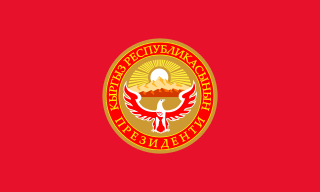
The history of the Kyrgyz people and the land now called Kyrgyzstan goes back more than 2,000 years. Although geographically isolated by its mountainous location, it had an important role as part of the historical Silk Road trade route. In between periods of self-government it was ruled by Göktürks, the Uyghur Empire, and the Khitan people, before being conquered by the Mongols in the 13th century; subsequently it regained independence but was invaded by Kalmyks, Manchus and Uzbeks. In 1876 it became part of the Russian Empire, remaining in the USSR as the Kirghiz Soviet Socialist Republic after the Russian Revolution. Following Mikhael Gorbachev's democratic reforms in the USSR, in 1990 pro-independence candidate Askar Akayev was elected president of the SSR. On 31 August 1991, Kyrgyzstan declared independence from Moscow, and a democratic government was subsequently established.

The Politics of Kyrgyzstan, officially known as the Kyrgyz Republic takes place in the framework of a parliamentary representative democratic republic, whereby the President is head of state and the Prime Minister of Kyrgyzstan is head of government. Executive power is exercised by the government. Legislative power is vested in both the government and parliament. The Economist Intelligence Unit has rated Kyrgyzstan as "hybrid regime" in 2016.

The Armed Forces of the Kyrgyz Republic, originally formed from former Soviet forces of the Turkestan Military District stationed in newly independent Kyrgyzstan, includes the Army, the Air Force, Air Defence Forces, the Northern and Southern Groups of Forces, Interior Troops, Agency of National Security and Border Troops.

Kyrgyzstan favors close relations with other members of the Commonwealth of Independent States, particularly Kazakhstan and Russia.
Kyrgyz is a Turkic language spoken by about four million people in Kyrgyzstan as well as China, Afghanistan, Kazakhstan, Tajikistan, Turkey, Uzbekistan, Pakistan and Russia. Kyrgyz is a member of the Kyrgyz–Kipchak subgroup of the Kypchak languages, and modern-day language convergence has resulted in an increasing degree of mutual intelligibility between Kyrgyz and Kazakh.

The som is the currency of the Kyrgyz Republic. The ISO 4217 currency code is KGS. The som is sub-divided into 100 tyiyn.

The coat of arms of the Kirghiz Soviet Socialist Republic was adopted on March 23, 1937 by the government of the Kirghiz Soviet Socialist Republic. The coat of arms is based on the coat of arms of the Soviet Union. It shows symbols of agriculture on a backdrop of the Tian Shan mountains, surrounded by a frame of folk art of the Kyrgyz people. The red star was added in 1948. The rising sun stands for the future of the Kyrgyz nation, the star as well as the hammer and sickle for the victory of communism and the "worldwide socialist community of states".

The Constitution of Kyrgyzstan is the supreme law of the Kyrgyz Republic. The constitution in force until 2010 was passed by referendum on 21 October 2007 and it is based on the first post-Soviet constitution originally adopted on 5 May 1993, a year and a half after the country had gained independence from the former Soviet Union. The 1993 constitution had been amended several times: first on 10 February 1996, then on 2 February 2003, and finally twice in quick succession on 9 November 2006 and 15 January 2007 after the Tulip Revolution of March 2005. The last two amendments were adopted under pressure from protracted public protests in the capital Bishkek, but they were annulled in September 2007 by the Constitutional Court, which restored the 2003 constitution and paved the way for another constitutional referendum in October 2007. The description that follows is based on the text of the October 2007 constitution.

The National Bank of the Kyrgyz Republic is the central bank of Kyrgyzstan and is primarily responsible for the strategic monetary policy planning of the country as well as the issuance of the national currency, the Som.

A constitutional referendum was held in France on 28 September 1958. Voters were asked whether they approved of the adoption of a constitution for the French Fifth Republic written by Charles de Gaulle. It was overwhelmingly approved, with 82.6% in favour. Voter turnout was 84.9% in Metropolitan France and 79.8% overall.

A constitutional referendum was held in Kyrgyzstan on 21 October 2007, following the constitutional crisis caused by amendments passed since the Tulip Revolution in 2005 being invalidated by the Constitutional Court of Kyrgyzstan on 14 September 2007. Voters were asked whether questions on a new constitution and electoral law. Both were approved by over 95% of voters.

Kyrgyzstan – United States relations are bilateral relations between Kyrgyzstan and the United States.

A constitutional referendum was held in Kyrgyzstan on 27 June 2010 to reduce presidential powers and strengthen democracy in the wake of the riots earlier in the year. Parliamentary elections followed on 10 October 2010.

Djoomart Kaipovich Otorbaev was the Prime Minister of Kyrgyzstan. On 25 March 2014 he replaced Zhantoro Satybaldiyev as acting prime minister until a new government was formed. On 3 April 2014 he was officially named prime minister. On 23 April 2015 he resigned.

A constitutional referendum was held in Kyrgyzstan on 11 December 2016. The constitutional amendments were approved by around 80% of voters.

Presidential elections were held in Kyrgyzstan on 15 October 2017. Incumbent President Almazbek Atambayev was not allowed to run again because the constitution sets a single six-year term for the head of state. Eleven candidates registered for the race, and from this field Sooronbay Jeenbekov of the Social Democratic Party of Kyrgyzstan won more than 50% of the vote, avoiding a runoff. Following certification of the results on 30 October, Jeenbekov was inaugurated as President of Kyrgyzstan on 24 November. The election, though not without flaws, was Central Asia’s first ever truly competitive election.

The Kyrgyz Air Force is the official air force of the Armed Forces of the Republic of Kyrgyzstan. Its current commander is Kylychbek Aidaraliev. The official holiday of the air forces is Aviation Day on August 18.













